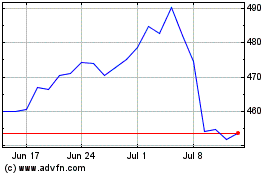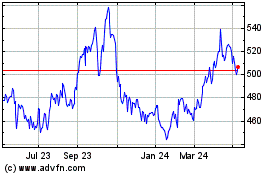4th UPDATE: Companies, Lawmakers Level Blame At Oil Hearing
May 11 2010 - 8:05PM
Dow Jones News
Irregular pressure readings, limitations in some testing and
deference on decision-making preceded last month's deadly oil-rig
explosion in the Gulf of Mexico, according to new details emerging
from testimony by oil company executives before the U.S.
Senate.
The testimony added to the picture of the accident on the
Transocean Ltd. (RIG) rig, which BP Plc (BP) was leasing in order
to drill an exploratory well with the help of Halliburton Co. (HAL)
employees. But a big question about whether procedures took place
in the correct sequence remained unanswered, as officials said that
none of them was familiar with the federally approved plans for
drilling an exploratory well that was located one mile below the
ocean's surface.
BP America President Lamar McKay told the Senate Environment and
Public Works Committee that "there were anomalous pressure-test
readings" in an exploratory well that was drilled into the ocean
floor before the explosion. Last month's blast has caused an oil
leak that has been spewing 5,000 barrels of oil a day into the sea
for roughly three weeks.
Halliburton safety chief Tim Probert, whose company was
cementing a pipeline into the hole bored into the sea floor, said
that only a particular type of test could have determined the
effectiveness of the cementing, but that test wasn't conducted.
Probert also said that the explosion occurred before Halliburton
had installed a final cement plug in the well on the ocean's floor,
at a time when workers had begun replacing heavy mud that had
exerted pressure on the well with lighter seawater, a sequence that
some people have called into question.
Probert said he wasn't sure how common it was to remove the
heavy mud before installing a cement plug that is the final barrier
put into place to guard against blowouts. That prompted Sen. Jeff
Sessions (R., Ala.) to angrily respond: "You do this business, do
you not? You're under oath, I'm just asking you a simple
question."
The hearing came as the Obama administration's Interior
Department announced plans to reorganize the Minerals Management
Service, which currently is responsible for both safety oversight
and collecting revenues from oil and gas leasing on federal lands.
Interior Secretary Ken Salazar, responding to criticism about the
potential for conflicts of interest, said the agency would be split
so the two functions would be separated.
Senate Environment and Public Works Committee Chairman Barbara
Boxer (D., Calif.) questioned BP America's chief on why the company
said it foresaw no problems when it requested government permission
to drill earlier this year. She also asked why Halliburton steered
clear of testing the cement "unless they ask you?"
Under repeated questioning, Prebert allowed that "we would feel
an obligation if we felt that the integrity of the cement was in
question."
As companies and lawmakers assigned blame, Senate Energy and
Natural Resources Committee Chairman Jeff Bingaman (D., N.M.) said
that multiple factors were at work.
"At the heart of this disaster are three interrelated systems--a
technological system of materials and equipment; a human system of
persons who operated the technological system; and a regulatory
system," he said. "These interrelated systems failed in a way that
many have said was virtually impossible. We need to examine closely
the extent to which each of these systems failed to do what it was
supposed to do."
BP's McKay, questioned repeatedly about the oil company's plans
to pay for costs related to the spill, said BP would pay all
"legitimate" claims. But he said that "claims have to have some
basis, have to have some substantiation."
Senators also said the oil industry and regulators weren't
prepared when disaster did strike. Speaking at a later hearing in
the Senate Environment and Public Works Committee, Sen. Arlen
Specter (D., Pa.), said oil companies could have had a containment
dome, which BP is now trying to lower onto the leaking well to
collect runaway oil, "ready for the spill rather than building one
after it happened."
Sen. Lisa Murkowski (R., Alaska) questioned why tests on using
chemical dispersants underwater hadn't been conducted before the
spill. BP is using dispersants to break up the oil on the ocean's
surface, but it has suspended the use of underwater dispersants
pending the outcome of Environmental Protection Agency tests.
Halliburton was performing the cementing work, which involves
filling up a space between the hole bored into the sea floor and
the casing inserted into the hole. Transocean Chief Executive
Steven Newman testified that "the one thing we know with certainty"
is that in the blast "there was a sudden, catastrophic failure of
the cement, the casing, or both."
"I agree," F.E. Beck, a petroleum engineer at Texas A & M
University, told the Senate Energy and Natural Resources Committee.
But he said that the wellhead casing "is also suspect."
BP has been unable to activate a blowout preventer, equipment
made of up heavy-duty valves that can shut of the well as a last
resort. Lawmakers questioned whether such equipment is subject to
enough testing.
"Why is it that the testing always seems to pass, and yet when
it was needed, it failed?" asked Sen. Bob Menendez (D., N.J.).
-By Siobhan Hughes and Corey Boles, Dow Jones Newswires;
202-862-6654; siobhan.hughes@dowjones.com
Bp (LSE:BP.)
Historical Stock Chart
From Mar 2024 to Apr 2024

Bp (LSE:BP.)
Historical Stock Chart
From Apr 2023 to Apr 2024
